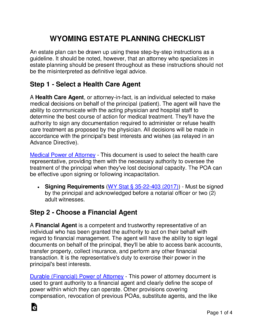Updated March 05, 2024
A Wyoming estate planning checklist is an organizational form that helps ensure a person’s affairs are prepared for the end of their life. Generally speaking, estate planning refers to the drafting of a written Last Will and Testament (‘Will’) or Revocable Living Trust; documents used to delineate how one’s assets and property will be distributed following their death. Both documents have their advantages and disadvantages but fundamentally perform the same function. Another aspect of estate planning which should be taken into account is the election of financial and health care agents through a power of attorney document (Durable Power of Attorney and Medical Power of Attorney respectively). This ensures that the estate owner has a representative ready should they become incapacitated.
How to Create an Estate Plan in Wyoming (6 steps)
- Select a Health Care Agent
- Choose a Financial Agent
- Create List of Assets
- Select Beneficiaries
- Draft Estate Planning Document
- Store the Documents
An estate plan can be drawn up using these step-by-step instructions as a guideline. It should be noted, however, that an attorney who specializes in estate planning should be present throughout as these instructions should not be the misinterpreted as definitive legal advice.
1. Select a Health Care Agent
A Health Care Agent, or attorney-in-fact, is an individual selected to make medical decisions on behalf of the principal (patient). The agent will have the ability to communicate with the acting physician and hospital staff to determine the best course of action for medical treatment. They’ll have the authority to sign any documentation required to administer or refuse health care treatment as proposed by the physician. All decisions will be made in accordance with the principal’s best interests and wishes (as relayed in an Advance Directive).
Medical Power of Attorney – This document is used to select the health care representative, providing them with the necessary authority to oversee the treatment of the principal when they’ve lost decisional capacity. The POA can be effective upon signing or following incapacitation.
- Signing Requirements – Must be signed by the principal and acknowledged before a notarial officer or two (2) adult witnesses.[1]
2. Choose a Financial Agent
A Financial Agent is a competent and trustworthy representative of an individual who has been granted the authority to act on their behalf with regard to financial management. The agent will have the ability to sign legal documents on behalf of the principal, they’ll be able to access bank accounts, transfer property, collect insurance, and perform any other financial transaction. It is the representative’s duty to exercise their power in the principal’s best interests.
Durable (Financial) Power of Attorney – This power of attorney document is used to grant authority to a financial agent and clearly define the scope of power within which they can operate. Other provisions covering compensation, revocation of previous POAs, substitute agents, and the like will often be included as well. The term “durable” refers to the powers enduring beyond the principal’s incapacitation.
- Signing Requirements – Must be signed by the principal and acknowledged before a notarial officer.[2]
Financial Powers Allowed:
- Real Property
- Tangible Personal Property
- Stocks and Bonds
- Commodities and Options
- Banks and Other Financial Institutions
- Operation of Entity or Business
- Insurance and Annuities
- Estates, Trusts and Other Beneficial Interests
- Claims and Litigation
- Personal and Family Maintenance
- Benefits from Governmental Programs or Civil or Military Service
- Retirement Plans
- Taxes
3. Create List of Assets
4. Select Beneficiaries
5. Draft Estate Planning Document
Most of the time, it is a choice between a Last Will and Testament, and a Revocable Living Trust when one is deciding how to distribute their estate. Both documents will pass the estate onto beneficiaries, however, the amount of time it takes to create the instrument and the distribution process following the estate owner’s death is where these documents differ.
Last Will and Testament (‘Will’) – This is the most common estate planning tool as it is comparatively easy and cheap to create. The testator (creator of the Will) chooses their executor to distribute the contents of their estate to the named beneficiaries. Following the testator’s death, the Will passes through probate court to determine its validity. Often a self-proving affidavit will be attached to the initial instrument to allow it to expedite the probate process. However, distributing the estate through a Will is a considerably lengthier process than that of a Living Trust.
- Signing Requirements – Must be signed by the testator and witnessed by two (2) competent witnesses.[3]
Living Trust (Revocable) – Creating a Living Trust is a more complicated process. The document is one that creates an entity into which the grantor (Trust owner) can transfer the ownership of their property and assets (which they can benefit from during their lifetime). The Trust document will name a trustee and successor trustee to manage the contents of the Trust until the grantor passes, at which point the Trust contents will be passed on to the beneficiaries. This process occurs outside of probate court and the public eye, thus enabling the inheritance to be delivered shortly after the grantor’s death.
- Signing Requirements – While there are no statutorily defined requirements for signing a trust document, it is recommended that all possible action be taken to prove its validity. The principal should sign, as should any witnesses, and if possible the signatures should be acknowledged before a notary public.
6. Store the Documents
Wyoming Estate Planning Laws
-
- Advance Directive – Wyoming Health Care Decisions Act
- Durable Power of Attorney – Uniform Power of Attorney Act
- Last Will and Testament – Wills, Decedents’ Estates and Probate Code
- Living Trust (Revocable) – Uniform Trust Code


